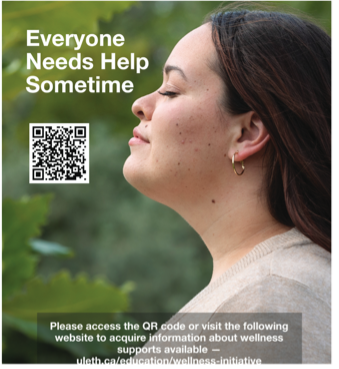Redesigning our Approach to Student Wellness
Redesigning Our Approach To Student Wellness
A collective of Education professors respond to the noticeable need for the revised approach to supporting student wellness.
Featured Educators:
Dr. Aaron Stout
Dr. Greg Ogilvie
Dr. Dawn Burleigh
Dr. Danny Balderson

"Our efforts are based on the understanding that well-being is a pre-condition for learning. Like many, we were noticing an increased prevalence of student mental health struggles and realized that we needed to address the underlying issues. Our committee approached the path forward as a programmatic response, knowing we needed something beyond individual actions when the challenge was impacting our students so broadly."
What did you change?
We have scaffolded the redesign of our program to embed and prioritize wellness. The structure of our program has been updated to feature:
- course outlines that include a statement highlighting the importance of wellness.
- a website we created that houses numerous support resources, shared through course outlines and QR codes on posters.
- promotion that has testimonials of faculty, students, and community members modelling their own focus on wellness.
- revised orientation days where community members highlight wellness supports and we embed wellness breaks for students (coulee walks, dodgeball games, or time for puzzles, for example).
- embedded wellness topics—such as movement in the classroom, mental health, social media, sleep, trauma-informed practice and suicide prevention—deliberately within one course.
- feedback, feedback, feedback! Based on ongoing student feedback, we continually re-design learning experiences based on topics that we, as faculty, may not have identified such as anxiety, sleep, and time management.

Image 1. An example of a community member testimonial for digital signage

Image 2. A poster support resource with a QR code

What is the impact?
It seems that, more than ever, students are balancing various dimensions of life. School pressures are met with commitments to family and jobs. From student feedback, we have learned that the instructor is quite often viewed as the primary support for students. If our goal is to support student success, we need to better situate ourselves to support their needs. With a coordinated approach, we can more suitably flex as an educational institution to normalize these conversations and have open dialogue about current student needs.
The feedback loop we have created, through surveys and conversations with students, allows us to respond and take meaningful action on a continual basis. From this feedback, we learned that students are interested in more wellness focused programming. Further, we have noticed, from our own reflections, that there is increased openness for students to advocate for their own well-being. The stigma associated with seeking out help and talking about one’s own mental health has really changed.
Our students in the Faculty of Education have a unique opportunity as they will influence the wellness of the students they will serve in their professional careers. This type of programing then models the importance of wellness in ways that they can carry forward to their future students. The impact, as a result, is felt throughout our community.
What challenges exist?
Finding time is always a challenge. None of us completed our previous graduate work or PhDs in wellness, so part of the challenge was that we were entering into a research area that was new to most of us. Ample literature and resources exist around the topic of wellness, but finding time to curate and select meaningful resources for our context can be a daunting task.
Further, we realized early on that adding to our existing program would be difficult, so we needed to find a different way to embed wellness into our current programming. By revising one course to embed wellness topics as well as enhancing our orientation days through a wellness lens, we were able to expand on our original programming without having to compromise key content. All aspects of this work included inviting community partners to support this initiative. We believe that this movement needs to involve both making space in our program for a wellness focus along with a collective commitment to continually address student wellbeing.
What opportunities exist?
Feedback from students is ‘we want more’. This both highlights the significance of the needs that exist and presents challenges for us as we continue to redesign the program to meets students’ needs. We see opportunities to bolster this work by using a more structured research agenda that aligns with the Scholarship of Teaching and Learning (SoTL). This may be the future of our wellness work.
Apart from the obvious improvement in students’ wellness and experience, we have embraced the opportunity to look at faculty wellness through this lens. This process has created a shift in the dialogue between faculty in how we approach our work. We see an increased sense of awareness which translates into more action and more targeted approaches to wellness across our faculty.

